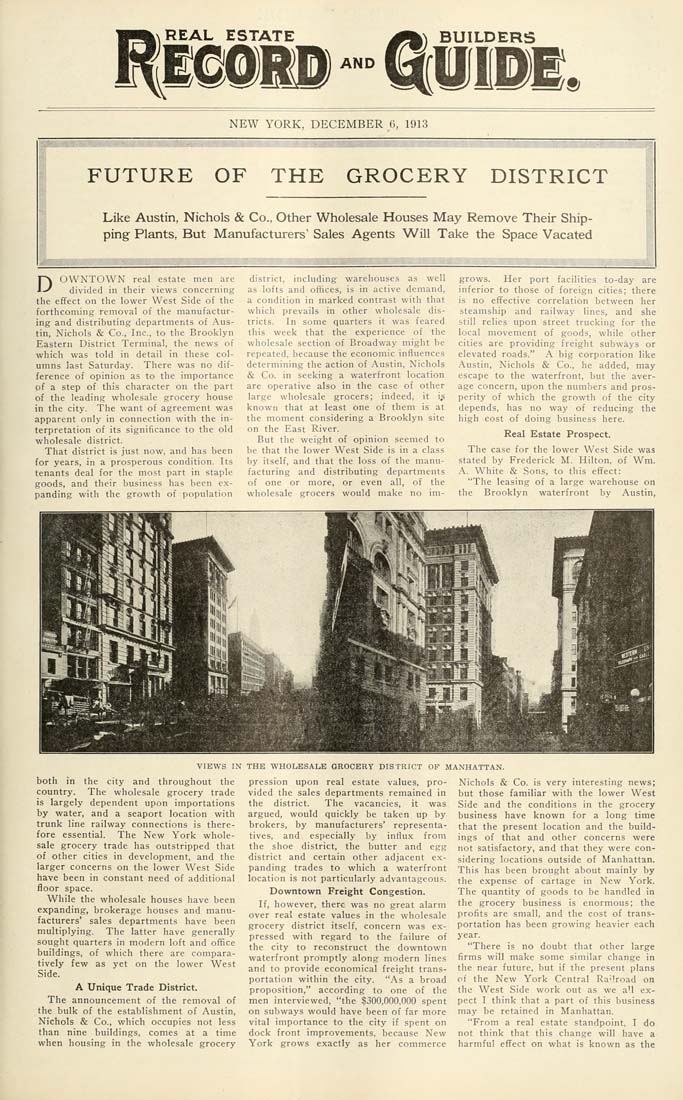Columbia University Libraries Digital Collections: The Real Estate Record
Use your browser's Print function to print these pages.
Real estate record and builders' guide: [v. 92, no. 2386]: December 6, 1913

Text version:
Please note: this text may be incomplete. For more information about this OCR, view About OCR text.
REAL ESTATE AND NEW YORK, DECEMBER 6, 1913 ■■illllllll ■llllllllllllill iiiiiiii^^ I FUTURE OF THE GROCERY DISTRICT Like Austin, Nichols & Co., Other Wholesale Houses May Remove Their Ship¬ ping Plants, But Manufacturers' Sales Agents Will Take the Space Vacated .■llliiillllllllliilllllllilllillllllliililliilllllll^ lilllllllllllilllillllllllilllillillll liiillliaiilliilllilillllilllllllilllllllliil^^^^^^^^^^^^^^^ DOWNTOWN real estate men are divided in their views concerning the effect on the lower West Side of the forthcoming removal of the manufactur¬ ing and distributing departments of Aus¬ tin, Nichols & Co., Inc., to the Brooklyn Eastern District Terminal, the news of which was told in detail in these col¬ umns last Saturday. There was no dif¬ ference of opinion as to the importance of a step of this character on the part of the leading wholesale grocery house in the city. The want of agreement was apparent only in connection with the in¬ terpretation of its significance to the old wholesale district. That district is just now, and has been for years, in a prosperous condition. Its tenants deal for the most part in staple goods, and their business has been ex¬ panding with the growth of population district, including warehouses as well as lofts and offices, is in active demand, a condition in marked contrast with that which prevails in other wholesale dis¬ tricts. In some quarters it was feared this week that the experience of the wholesale section of Broadway might be repeated, because the economic influences determining the action of Austin, Nichols & Co. in seeking a waterfront location are operative also in the case of other large wholesale grocers; indeed, it i^ known that at least one of them is at the moment considering a Brooklyn site on the East River. But the weight of opinion seemed to be that the lower West Side is in a class by itself, and that the loss of the manu¬ facturing and distributing departments of one or more, or even all, of the wholesale grocers would make no im- grows. Her port facilities to-day are inferior to those of foreign cities; there is no effective correlation between her steamship and railway lines, and she still relies upon street trucking for the local movement of goods, while other cities are providing freight subways or elevated roads." A big corporation like .^.ustin, Nichols & Co., he added, may escape to the waterfront, but the aver¬ age concern, upon the numbers and pros¬ perity of which the growth of the city depends, has no way of reducing the high cost of doing business here. Real Estate Prospect. The case for the lower West Side was stated by Frederick M. Hilton, of Wm. .A. White & Sons, to this effect: "The leasing of a large warehouse on the Brooklyn waterfront by Austin, VIEWS IN THE WHOLESALE GROCERY DISTRICT OF MANHATTAN. both in the city and throughout the country. The wholesale grocery trade is largely dependent upon importations by water, and a seaport location with trunk line railway connections is there¬ fore essential. The New York whole¬ sale grocery trade has outstripped that of other cities in development, and the larger concerns on the lower West Side have been in constant need of additional floor space. While the wholesale houses have been expanding, brokerage houses and manu¬ facturers' sales departments have been multiplying. The latter have generally sought quarters in modern loft and office buildings, of which there are compara¬ tively few as yet on the lower West Side. A Unique Trade District. The announcement of the removal of the bulk of the establishment of Austin, Nichols & Co., which occupies not less than nine buildings, comes at a time when housing in the wholesale grocery pression upon real estate values, pro¬ vided the sales departments remained in the district. The vacancies, it was argued, would quickly be taken up by brokers, by manufacturers' representa¬ tives, and especially by influ.x from the shoe district, the butter and egg district and certain other adjacent ex¬ panding trades to which a waterfront location is not particularly advantageous. Downtown Freight Congestion. If, however, there was no great alarm over rea! estate values in the wholesale grocery district itself, concern was ex¬ pressed with regard to the failure of the city to reconstruct the downtown waterfront promptly along modern lines and to provide economical freight trans¬ portation within the city. "As a broad proposition," according to one of the men interviewed, "the $300,000,000 spent on subways would have been of far more vital importance to the city if spent on dock front improvements, because New York grows exactly as her commerce Nichols & Co. is very interesting news; but those familiar with the lower West Side and the conditions in the grocery business have known for a long time that the present location and the build¬ ings of that and other concerns were not satisfactory, and that they were con¬ sidering locations outside of Manhattan. This has been brought about mainly by the expense of cartage in New York. The quantity of goods to be handled in the grocery business is enormous; the profits are small, and the cost of trans¬ portation has been growing heavier each year. "There is no doubt that other large firms will make some similar change in the near future, but if the present plans of the New York Central Ra'lroad on the West Side work out as we a'l ex¬ pect I think that a part of this business may be retained in Manhattan. "From a real estate standpoint. I do not think that this change will have a harmful effect on what is known as the